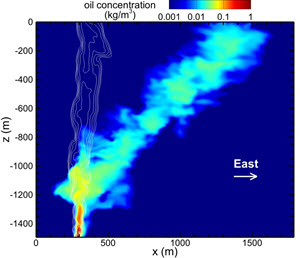
A Large Eddy Simulation of oil droplet (color contours) and gas bubble (white lines) plumes emerging from 1500 m below the surface into a stratified ocean, including 3D Coriolis force and west-to-east current effects. (Simulation performed by Dr. Di Yang, University of Houston)
Deep ocean oil plumes that formed from the Deepwater Horizon spill and their subsequent rise through the water column were greatly influenced by physical mixing mechanisms such as turbulence, Langmuir circulations, and sub-mesoscale eddies.
These mixing processes are crucial variables needed for existing models to accurately predict a plume’s overall size, shape, and transport direction. Improving our understanding about these processes that affect a spill’s development can better inform response efforts.
The Gulf of Mexico Research Initiative recently awarded Dr. Charles Meneveau a grant to develop an enhanced Large Eddy Simulation (LES) framework for predicting multiscale physical dispersion mechanisms and estimating the effectiveness of remediation strategies. The framework will incorporate relevant length and time scales and address specific needs of oil droplet dispersion ocean modeling.
Different-sized oil droplets rise at varying rates and interact through mixing mechanisms in different ways. These physical interactions affect how parts of the plume move to the surface and create slicks of various shapes and sizes. If applied, chemical dispersants can reduce droplet diameters and alter a plume’s composition, biodegradation susceptibility, transport direction, size, and surface signature.
The team will adapt droplet size distribution models in LES that predict plumes with multiple-size oil droplets by including turbulence and dispersant effects on oil transport. A technique known as the Extended Nonperiodic Domain LES for Scalar transport (ENDLESS) will be developed to simulate oil plume transport in the ocean mixed layer at scales that can capture simultaneously small-scale turbulence and regional-scale transport that affect oil transport predictions. The results will improve how regional models trace oil droplet plume dispersion.
The researchers will use their model to also perform LES computations that analyze the efficacy and efficiency of deep-sea and surface dispersant application and impacts on oil plume evolution under varying application scenarios (location, quantity, type of dispersant) and environmental conditions.
Meneveau explained that this research will be used to develop engineering tools for rapid real-time assessment, helping to improve emergency response and spill monitoring, “Applying state-of-the-art enhanced simulation tools to the field of oil spill modeling will help develop fundamental new insights in a research area with direct applications to the challenges confronting the Gulf of Mexico region and the energy industry.”
The project’s researchers are Charles Meneveau of Johns Hopkins University, Marcelo Chamecki of University of California Los Angeles, and Di Yang of the University of Houston. Their project is Transport and Fate of Oil in the Upper Ocean: Studying and Modeling Multi-Scale Physical Dispersion Mechanisms and Remediation Strategies Using Large Eddy Simulation.
***************
The Gulf of Mexico Research Initiative (GoMRI) is a 10-year independent research program established to study the effect, and the potential associated impact, of hydrocarbon releases on the environment and public health, as well as to develop improved spill mitigation, oil detection, characterization and remediation technologies. An independent and academic 20-member Research Board makes the funding and research direction decisions to ensure the intellectual quality, effectiveness and academic independence of the GoMRI research. All research data, findings and publications will be made publicly available. The program was established through a $500 million financial commitment from BP. For more information, visit http://gulfresearchinitiative.org/.
